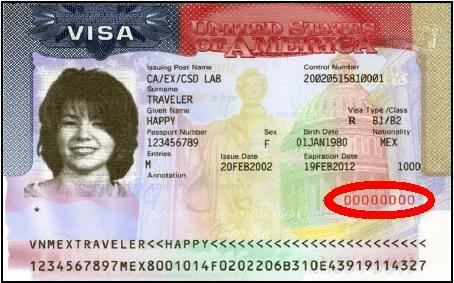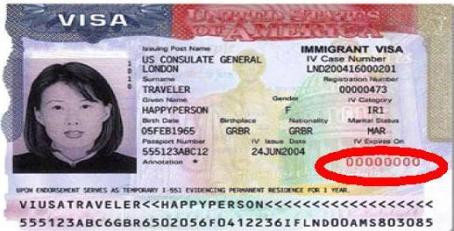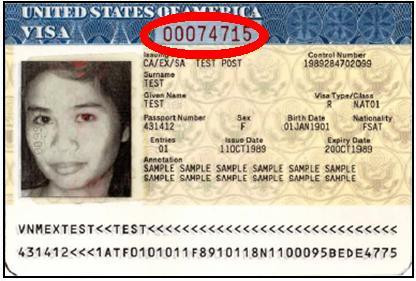Understanding your US visa is crucial, especially when it comes to locating specific details like your visa number. This number, also known as the visa foil number, is essential for various administrative processes and verifying your authorization to enter the United States. This guide will provide you with a clear understanding of where to find this number on your US visa and other key information present on the document.
The visa number is typically printed in red ink on the visa document. While its location has varied slightly over time, it’s generally found on the bottom right side of newer visa formats. It’s usually composed of eight numeric characters, but in some instances, it might start with a letter followed by seven numbers.
To help you pinpoint your visa number, let’s explore where it’s located on different visa layouts.
 nonimmigrant visa number
nonimmigrant visa number
Finding the Visa Number on a Sample US Visa Document
As you can see in the example above, the visa number is prominently displayed in red on the bottom right corner of the visa foil. This is the standard location you should check first.
 where is location of the visa number
where is location of the visa number
Another Example Highlighting the US Visa Number Location
This second example reinforces the typical placement of the visa number. Regardless of the slight variations in visa design over the years, the bottom right area is the most consistent location to look for this crucial identifier.
 finding us visa number
finding us visa number
Close-up View of a US Visa Number
This close-up image provides a clearer view of the visa number itself. Notice the red color and the sequence of digits. This number is unique to your visa and is used to access your visa information in official systems.
Key Information on Your US Visa
Besides the visa number, your US visa contains a wealth of other important information. Understanding these details is equally important for navigating your entry and stay in the United States. Here’s a breakdown of the common elements you’ll find:
-
Issuing Post Name: This indicates the U.S. embassy or consulate where your visa was issued. Knowing the issuing post can be helpful if you need to contact them for any visa-related inquiries.
-
Visa Holder’s Last Name and First Name: These fields clearly state your legal name as it appears in your passport. Ensure these names are accurate and match your other travel documents.
-
Sex: Indicates your gender, denoted as F (female) or M (male).
-
Date of Birth: Your date of birth is listed for identification purposes.
-
Nationality: This specifies your country of citizenship.
-
Passport Number: Your passport number is linked to your visa. It’s important to travel with the same passport that is associated with your valid US visa.
-
Visa Type: This crucial field indicates the category of your visa, such as B-2 for tourist visas, F-1 for student visas, or other categories depending on your purpose of travel.
-
Entries: This specifies how many times you are permitted to enter the U.S. with this visa. “S” denotes a single-entry visa, while “M” indicates a multiple-entry visa. Multiple entry visas are generally more flexible for frequent travelers.
-
Issue Date: The date your visa was issued is important for calculating the validity period.
-
Expiration Date: This is the date your visa ceases to be valid. You must enter the United States before this date. Note that the expiration date is for entry, and your permitted stay within the US might be different and determined by Customs and Border Protection upon arrival.
-
Annotations: This section may contain notes or remarks left by the U.S. embassy or consulate. These annotations are typically for official use and might provide additional context regarding your visa.
It’s important to familiarize yourself with all these elements on your visa to ensure a smooth travel experience and understand the conditions of your visa.
Nonimmigrant vs. Immigrant Visa Numbers
It’s worth noting the distinction between visa numbers for nonimmigrant and immigrant visas. For nonimmigrant visas, like visitor visas or student visas, the visa number is temporary and linked to the validity of that specific visa.
On the other hand, for immigrant visas (Green Cards), the concept of a visa number takes on a slightly different meaning related to visa availability.
Immigrant Visa Number Availability and the Visa Bulletin
Immigrant visa number availability is tied to annual limits set by U.S. immigration law on the number of green cards issued each year. This means that even after your I-130 petition (Petition for Alien Relative) is approved, you might need to wait for an immigrant visa number to become available.
The Visa Bulletin, published monthly by the U.S. Department of State, provides updates on the availability of immigrant visa numbers. It outlines waiting times and priority dates for different categories of family-based and employment-based green cards. Understanding how to read the Visa Bulletin is essential for individuals seeking to immigrate to the United States.
If you are pursuing a family-based immigrant visa, your U.S. citizen or lawful permanent resident relative will initiate the process by filing Form I-130. The Visa Bulletin will then be a key resource in monitoring the progress of your case and estimating when an immigrant visa number might become available for you.
Source: U.S. Department of State

